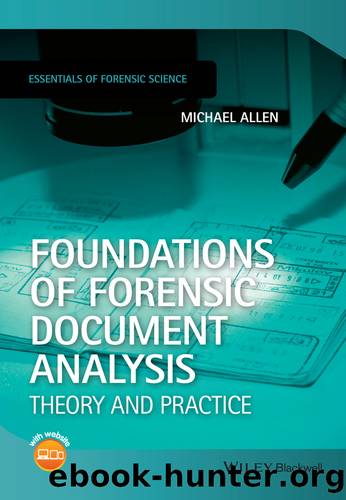Foundations of Forensic Document Analysis by Allen Michael J.;

Author:Allen, Michael J.; [Allen, Michael J.]
Language: eng
Format: epub
Publisher: John Wiley & Sons, Incorporated
Published: 2015-09-28T00:00:00+00:00
Figure 4.14 Letter e printed with a laser printer showing the molten appearance of raised toner on a paper surface (x30 approx.).
The cylindrical drum can, with use, develop small imperfections on its surface. These imperfections may attract toner particles such that each time documents are printed using it there will be a characteristic mark on the paper. The position and shape of such marks can provide forensic evidence linking documents printed using the same laser printer (specifically the drum) or linking documents to a particular printer. The drum marks are often very small and require low power magnification to be seen.
Given the likelihood of a background scatter of toner particles on a document, it is important to distinguish them from marks caused by drum defects. A difference between them is that background scatter is random whereas drum marks will appear repeatedly on documents, usually in the same relative position one to another on the document. The diameter of many laser printer drums is quite small such that to print a sheet of A4 paper requires perhaps three rotations of the drum. This will cause the drum mark to appear three times down the page spaced equally apart. Background scatter usually consists of one or a few toner particles, whereas drum marks often have a shape associated with them (Figure 4.15). Any shape to drum marks will add to their forensic significance.
Download
This site does not store any files on its server. We only index and link to content provided by other sites. Please contact the content providers to delete copyright contents if any and email us, we'll remove relevant links or contents immediately.
| Administration & Medicine Economics | Allied Health Professions |
| Basic Sciences | Dentistry |
| History | Medical Informatics |
| Medicine | Nursing |
| Pharmacology | Psychology |
| Research | Veterinary Medicine |
Periodization Training for Sports by Tudor Bompa(7929)
Why We Sleep: Unlocking the Power of Sleep and Dreams by Matthew Walker(6362)
Paper Towns by Green John(4805)
The Immortal Life of Henrietta Lacks by Rebecca Skloot(4262)
The Sports Rules Book by Human Kinetics(4079)
Dynamic Alignment Through Imagery by Eric Franklin(3925)
ACSM's Complete Guide to Fitness & Health by ACSM(3827)
Kaplan MCAT Organic Chemistry Review: Created for MCAT 2015 (Kaplan Test Prep) by Kaplan(3804)
Introduction to Kinesiology by Shirl J. Hoffman(3628)
Livewired by David Eagleman(3535)
The River of Consciousness by Oliver Sacks(3420)
The Death of the Heart by Elizabeth Bowen(3342)
Alchemy and Alchemists by C. J. S. Thompson(3298)
Descartes' Error by Antonio Damasio(3167)
Bad Pharma by Ben Goldacre(3102)
The Emperor of All Maladies: A Biography of Cancer by Siddhartha Mukherjee(2932)
The Gene: An Intimate History by Siddhartha Mukherjee(2929)
The Fate of Rome: Climate, Disease, and the End of an Empire (The Princeton History of the Ancient World) by Kyle Harper(2877)
Kaplan MCAT Behavioral Sciences Review: Created for MCAT 2015 (Kaplan Test Prep) by Kaplan(2819)
